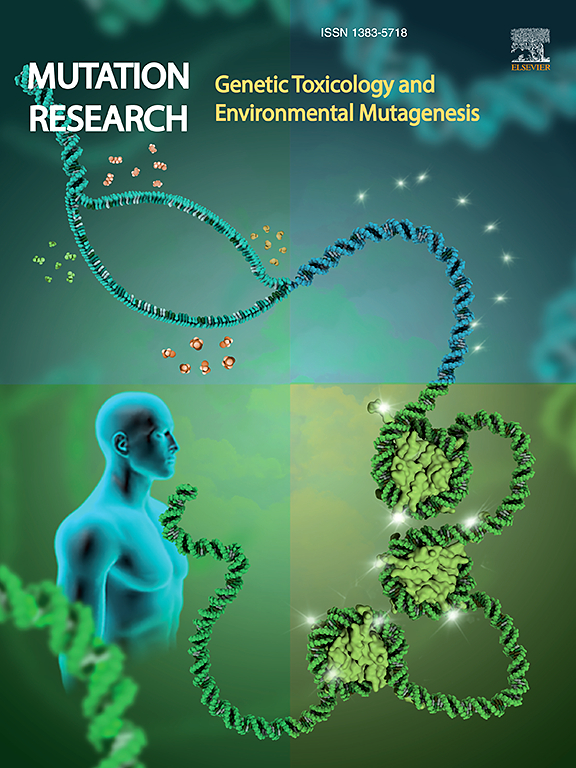Radiology personnel chronically exposed to low-dose ionizing radiation: Assessment of genotoxic damage with the buccal micronucleus cytome assay
IF 2.5
4区 医学
Q3 BIOTECHNOLOGY & APPLIED MICROBIOLOGY
Mutation research. Genetic toxicology and environmental mutagenesis
Pub Date : 2025-06-12
DOI:10.1016/j.mrgentox.2025.503872
引用次数: 0
Abstract
Objective
This study aimed to assess the genotoxic effects of chronic occupational exposure to low-dose ionizing radiation among healthcare professionals employed at three hospitals in Aydın, Turkey: Aydın Adnan Menderes University Research and Application Hospital (ADU-UAH), Atatürk State Hospital, and Aydın State Hospital. The exposed group comprised 27 healthcare workers routinely operating in radiation-related departments, while 27 matched individuals with no known exposure constituted the control group.
Methods
Genetic damage was evaluated using the exfoliated buccal micronucleus cytome (BMCyt) assay, a validated and non-invasive method for human biomonitoring. Frequencies of nuclear abnormalities—including micronuclei, binucleated cells, nuclear buds, condensed chromatin, karyorrhexis, karyolysis, and pyknotic cells—were systematically recorded and compared between groups.
Results
A statistically significant increase in all genotoxic markers was observed in the exposed group compared to controls (p < 0.05). The highest frequency of micronucleated cells was found in workers at Aydın State Hospital (32.38 ‰), approximately 30-fold higher than the control group (2.84 ‰). Healthcare workers at ADU-UAH and Atatürk State Hospital exhibited moderate yet notable elevations, with frequencies of 24.85 ‰ and 17.28 ‰, respectively. Sex-stratified analysis revealed minor but statistically significant differences, with male workers showing slightly higher genotoxicity levels (p < 0.05), although female staff exhibited higher nuclear anomalies at certain institutions.
Conclusion
Our findings indicate that chronic exposure to low-dose ionizing radiation is associated with increased genomic instability among healthcare workers. The elevated frequency of nuclear abnormalities highlights a potential long-term mutagenic risk in occupational settings. These results underscore the urgent need for reinforced radiation safety protocols, routine biomonitoring, and institutional policy revisions to mitigate genotoxic risks. Further studies are warranted to elucidate the mechanisms underlying radiation-induced genomic damage and to better understand individual susceptibility patterns in exposed populations.
长期暴露于低剂量电离辐射的放射学人员:用口腔微核细胞组测定法评估遗传毒性损伤
目的本研究旨在评估土耳其Aydın三家医院(Aydın Adnan Menderes大学研究与应用医院(ADU-UAH)、atatrk国立医院和Aydın国立医院)的医疗保健专业人员慢性职业暴露于低剂量电离辐射的遗传毒性效应。受照组由27名在辐射相关部门常规工作的医护人员组成,而27名没有已知受照的匹配个体组成对照组。方法采用脱落颊微核细胞组(BMCyt)测定法对遗传损伤进行评估,BMCyt是一种经过验证的无创人体生物监测方法。系统记录核异常的频率,包括微核、双核细胞、核芽、浓缩染色质、核分裂、核溶解和固缩细胞,并比较各组之间的差异。结果暴露组各基因毒性指标均较对照组升高,差异有统计学意义(p <; 0.05)。微核细胞出现频率最高的是Aydın国立医院的工人(32.38 ‰),约为对照组(2.84 ‰)的30倍。ADU-UAH和atatatrk州立医院的医护人员表现出中度但显著的升高,频率分别为24.85 ‰和17.28 ‰。性别分层分析显示了微小但具有统计学意义的差异,男性工人的遗传毒性水平略高(p <; 0.05),尽管某些机构的女性员工表现出更高的核异常。结论:我们的研究结果表明,长期暴露于低剂量电离辐射与医护人员基因组不稳定性增加有关。核异常频率的升高突出了职业环境中潜在的长期诱变风险。这些结果强调迫切需要加强辐射安全协议,常规生物监测和制度政策修订,以减轻遗传毒性风险。需要进一步的研究来阐明辐射引起的基因组损伤的机制,并更好地了解暴露人群的个体易感性模式。
本文章由计算机程序翻译,如有差异,请以英文原文为准。
求助全文
约1分钟内获得全文
求助全文
来源期刊
CiteScore
3.80
自引率
5.30%
发文量
84
审稿时长
105 days
期刊介绍:
Mutation Research - Genetic Toxicology and Environmental Mutagenesis (MRGTEM) publishes papers advancing knowledge in the field of genetic toxicology. Papers are welcomed in the following areas:
New developments in genotoxicity testing of chemical agents (e.g. improvements in methodology of assay systems and interpretation of results).
Alternatives to and refinement of the use of animals in genotoxicity testing.
Nano-genotoxicology, the study of genotoxicity hazards and risks related to novel man-made nanomaterials.
Studies of epigenetic changes in relation to genotoxic effects.
The use of structure-activity relationships in predicting genotoxic effects.
The isolation and chemical characterization of novel environmental mutagens.
The measurement of genotoxic effects in human populations, when accompanied by quantitative measurements of environmental or occupational exposures.
The application of novel technologies for assessing the hazard and risks associated with genotoxic substances (e.g. OMICS or other high-throughput approaches to genotoxicity testing).
MRGTEM is now accepting submissions for a new section of the journal: Current Topics in Genotoxicity Testing, that will be dedicated to the discussion of current issues relating to design, interpretation and strategic use of genotoxicity tests. This section is envisaged to include discussions relating to the development of new international testing guidelines, but also to wider topics in the field. The evaluation of contrasting or opposing viewpoints is welcomed as long as the presentation is in accordance with the journal''s aims, scope, and policies.

 求助内容:
求助内容: 应助结果提醒方式:
应助结果提醒方式:


